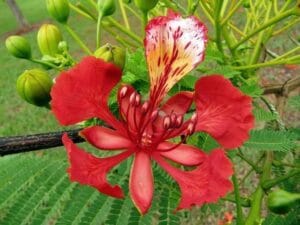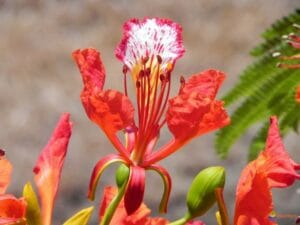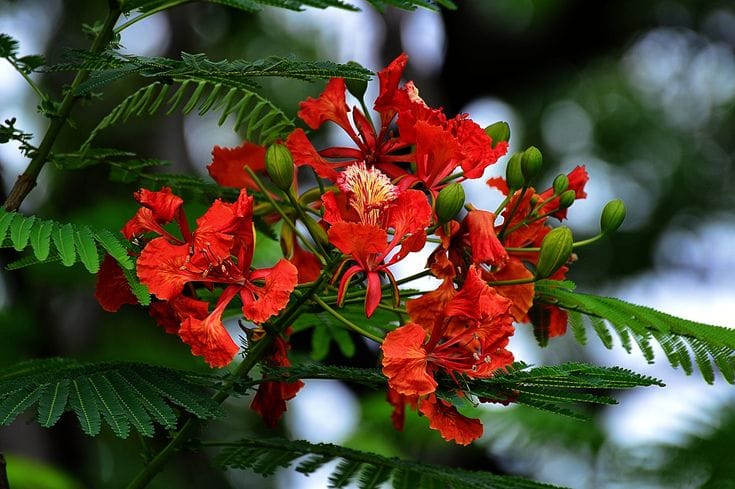The Gulmohar plant also called the Flame of the Forest or Delonix regia is one of the most loved ornamental trees in India. With its bright red and orange blossoms spread across wide branches it adds a burst of colour to gardens streets and parks. The Gulmohar plant is admired not only for its beauty but also for the shade and greenery it provides during hot Indian summers. If you are planning to grow this plant at home or in your garden you should understand the right care methods so that it thrives and flowers beautifully. This detailed guide covers everything from growing tips to benefits and flowering secrets for the Gulmohar plant.
Introduction to Gulmohar Plant
The Gulmohar tree belongs to the Fabaceae family and is native to Madagascar. Over time it has become widely popular in tropical and subtropical regions including India. In Hindi it is often called Krishnachura or Mayflower tree. It is a fast growing deciduous tree that can reach up to 12 to 15 meters in height with a wide spreading canopy. Its leaves are feathery and delicate while the flowers are large and striking in shades of scarlet orange and yellow.
In India the Gulmohar plant is commonly seen along roadsides in housing societies and in large parks. It is also planted in home gardens where space allows because it offers both beauty and shade.

How to Grow Gulmohar Plant
Growing a Gulmohar plant is easy if the right conditions are provided. Here are the main steps to follow:
1. Choosing the Right Location
A sunny spot is necessary for the Gulmohar plant. Given the size of the tree, be sure to pick an open area where the canopy can spread out. Because the roots and branches can spread widely, if you are planting in a home garden, keep it away from the house or any boundary walls.
2. Soil Requirements
Well-drained soil is ideal for the plant’s growth. The ideal soil is red or sandy loam with a high level of organic matter. Steer clear of soggy soil as it may harm the roots. Before planting, add compost and sand to heavy clay garden soil.
3. Propagation
Typically, seeds are used to grow the Gulmohar plant. Pretreatment is necessary for improved germination of the hard-coated seeds. Before planting, soak the seeds in warm water for a full day. To increase germination rates, you can also use sandpaper to gently scratch the seed coat. Plant the seeds in seed trays or tiny pots that have been filled with nursery soil. Typically, germination takes seven to fourteen days.
4. Transplanting
The seedlings can be moved to the main garden once they reach a height of 30 to 45 cm. Create a pit that is two feet deep and two feet wide. Plant the sapling after mixing garden soil with cow dung manure or compost. After planting, give it plenty of water.
5. Watering
In its early years, the Gulmohar plant requires frequent watering. As it ages, it can withstand drought and needs less frequent watering. Water young plants once every two to three days during the summer. Although mature trees can rely on rainfall, deep watering occasionally is beneficial during dry spells.

6. Fertilizer
To keep soil fertile, apply compost or organic manure twice a year. Healthy growth is also supported by a fertilizer that is balanced and high in potassium, phosphorus, and nitrogen. To promote more blooms, fertilizers should be applied prior to the flowering season.
7. Pruning and Maintenance
The Gulmohar tree gains strength through pruning. Regularly trim any dead or weak branches. If you would like a cleaner trunk, you can also trim the lower branches. Steer clear of excessive pruning as it may interfere with flowering.
Flowering Season of Gulmohar Plant
The gorgeous flowers of the Gulmohar plant are among its most alluring characteristics. In India, the flowering season typically lasts from April to June. The flowering season may continue into the monsoon season in some areas.
The flowers are big and clustered together. Each flower has one upright petal with white and yellow markings and four spreading petals that are either bright red or orange. The tree is also known as the Flame Tree because of the flowers that cover the entire canopy, giving the impression that it is on fire.
Benefits of Gulmohar Plant
The Gulmohar plant is not only beautiful but also highly beneficial. Here are some of its main advantages:
1. Environmental Benefits
The wide canopy of the Gulmohar tree provides excellent shade. It reduces the heat in surrounding areas and improves air quality. The tree also absorbs carbon dioxide and helps fight pollution.

2. Ornamental Value
The bright red and orange flowers make it a favourite choice for landscaping. It is often planted along roadsides schools and parks to add beauty and greenery.
3. Medicinal Uses
Some parts of the plant are used in traditional medicine. The leaves and bark have been known to possess anti inflammatory and healing properties though they should be used carefully under expert guidance.
4. Economic Uses
The wood of the Gulmohar plant is used for fuel and in some cases for making low grade furniture. The tree is also planted in agroforestry systems for shade and soil improvement.
5. Attracts Birds and Insects
The flowers of the Gulmohar attract bees butterflies and birds which supports biodiversity in your garden.
Common Problems and Solutions
Like all plants the Gulmohar may face some challenges. Here are common issues and how to solve them:
- Poor Germination – Pre treat seeds by soaking in warm water or scarifying before sowing.
- Yellow Leaves – This can happen due to poor drainage. Improve soil aeration and avoid overwatering.
- Pests – Caterpillars and beetles sometimes attack the leaves. Use organic neem spray to control them.
- No Flowers – Lack of sunlight or nutrients can reduce flowering. Ensure the plant gets full sun and apply fertilizer before flowering season.

Tips for Growing Gulmohar at Home
- Plant Gulmohar in open ground rather than pots because it grows into a large tree
- Provide organic compost every 6 months for healthy growth
- Do not over prune as it can affect flowering
- If planting near a building maintain at least 15 feet distance
- Protect young plants from grazing animals in rural areas
Vastu and Cultural Significance of Gulmohar
In Indian culture the Gulmohar plant is also considered auspicious. According to vastu shastra planting trees that provide shade and beauty in the south or west direction of a house is believed to bring positive energy. The Gulmohar tree is often associated with prosperity and harmony in communities where it is planted.
Conclusion
The Gulmohar plant is truly a gift of nature with its fiery blossoms and wide spreading branches. Growing this plant in your garden or surroundings not only enhances beauty but also improves the environment. With proper care in terms of soil water sunlight and nutrition the Gulmohar will reward you with shade during summer and a spectacular display of flowers every year.
Whether you are a gardener a homeowner or simply a nature lover the Gulmohar plant is worth adding to your green space. Follow the tips shared in this guide to enjoy the full beauty and benefits of this majestic tree.
FAQ
Q1. How long does a Gulmohar plant take to grow into a tree?
A Gulmohar plant grows quickly and can reach a height of 5 to 8 feet within 2 to 3 years. It usually takes 8 to 10 years to develop into a full sized tree with a wide canopy.
Q2. When does the Gulmohar plant start flowering?
The Gulmohar plant generally starts flowering after 3 to 4 years of planting if grown in the right conditions with full sunlight and proper nutrition.
Q3. Which month is best for planting Gulmohar in India?
The best time to plant Gulmohar is during the monsoon season from June to August because the soil has enough moisture for the young sapling to establish roots.
Q4. Can Gulmohar be grown in pots or containers?
Gulmohar is a large tree so it is not suitable for growing in small pots or containers. However you can grow it in large containers temporarily during the seedling stage and later transplant it to the ground.
Q5. Does Gulmohar plant need a lot of water?
Young Gulmohar plants need regular watering about two to three times a week. Once the tree matures it becomes drought tolerant and survives on natural rainfall with occasional deep watering.
Q6. Why is my Gulmohar plant not flowering?
Lack of sunlight poor soil nutrients or young age of the tree are common reasons. Ensure the plant gets full sun use organic compost and wait for it to reach maturity.
Q7. What is the lifespan of a Gulmohar tree?
A Gulmohar tree usually lives for 30 to 40 years depending on the growing conditions and care.
Q8. Is Gulmohar a good tree for home gardens?
Yes if you have enough space Gulmohar is a wonderful tree for home gardens because it provides shade beauty and attracts birds and butterflies. However avoid planting too close to the house because of its wide roots and branches.
Q9. Does the Gulmohar tree have any medicinal uses?
Yes parts of the plant like leaves and bark are used in traditional remedies for inflammation and minor ailments. Always consult an expert before using it for medicinal purposes.
Q10. Is Gulmohar tree good as per vastu shastra?
According to vastu the Gulmohar tree is considered positive when planted in open spaces like gardens parks and society compounds as it brings harmony and prosperity.

